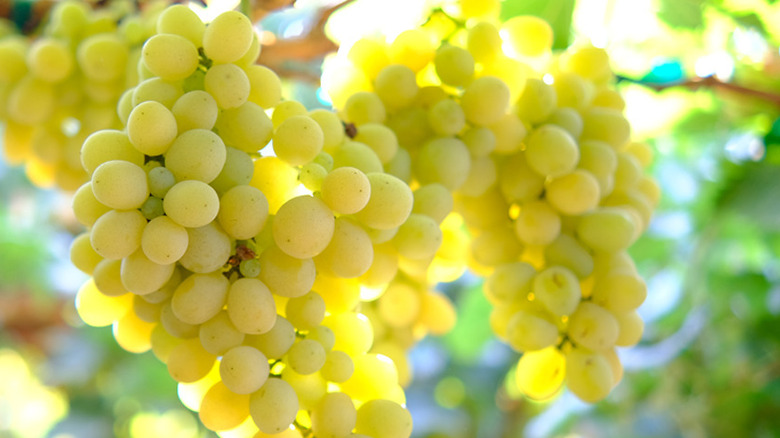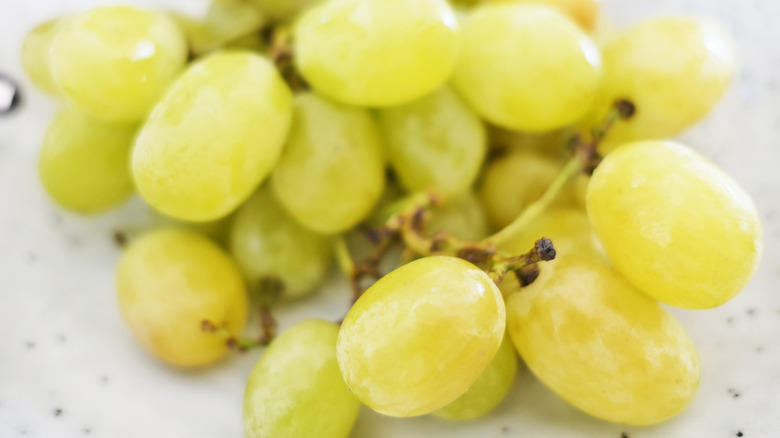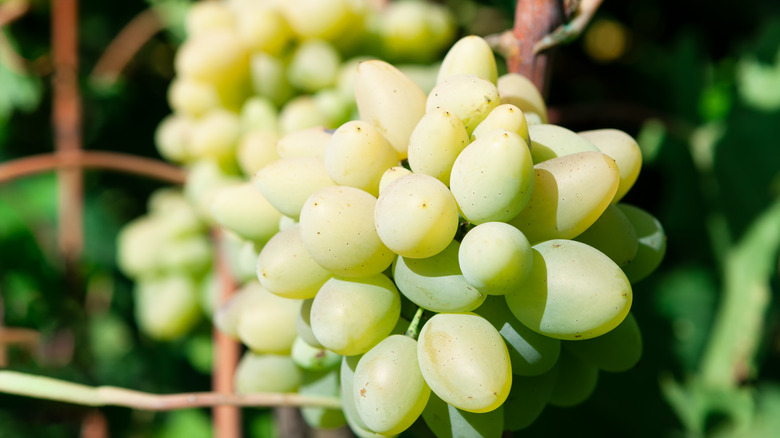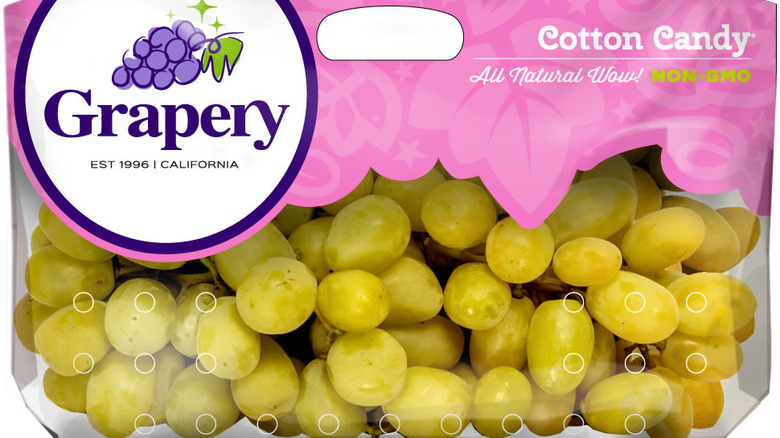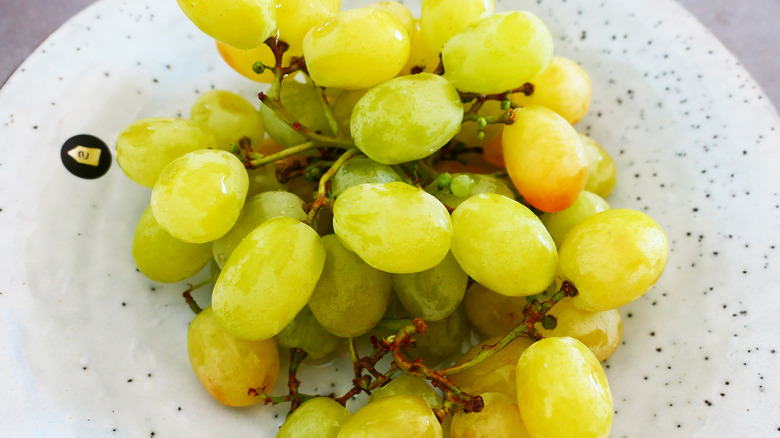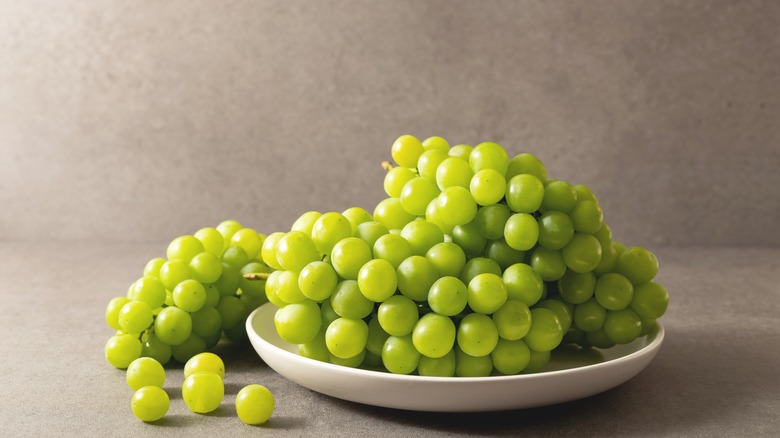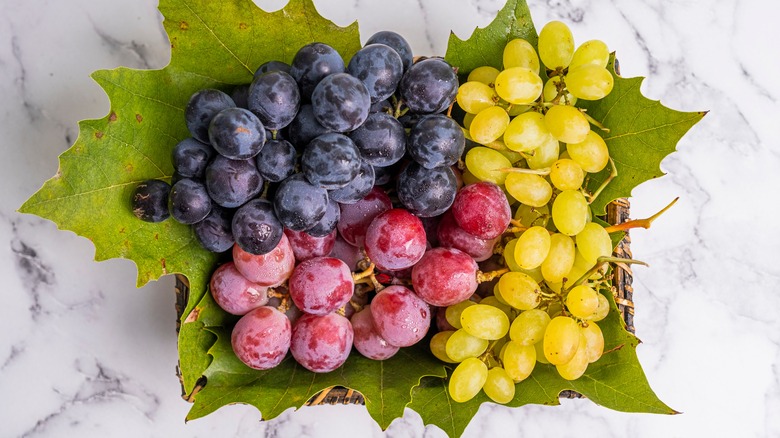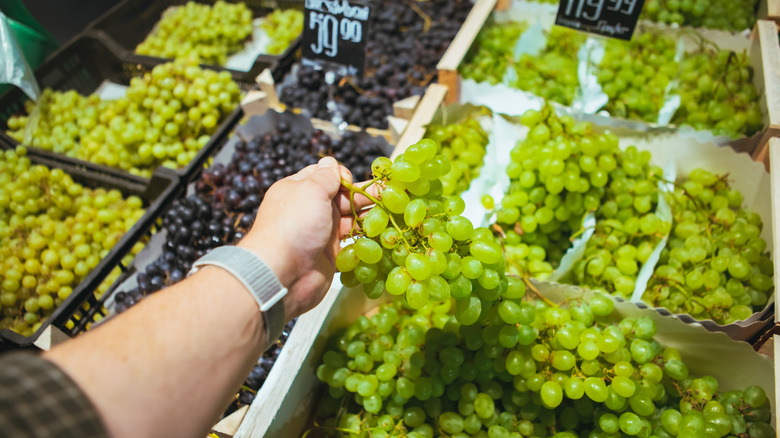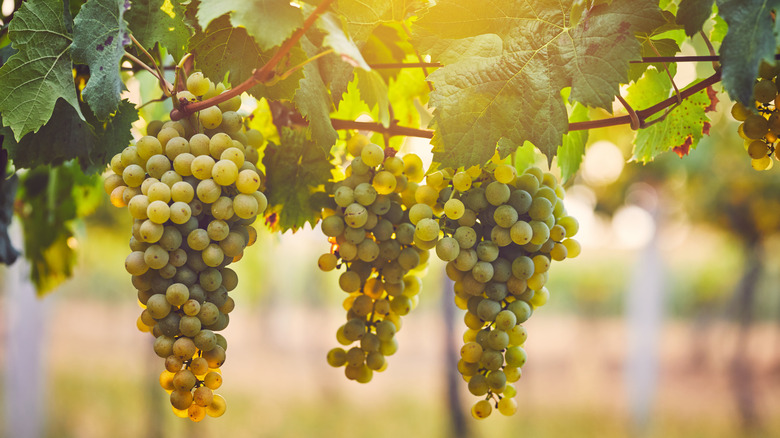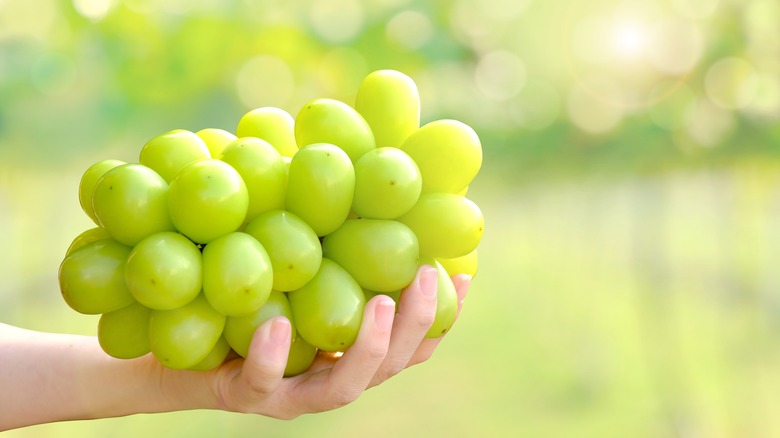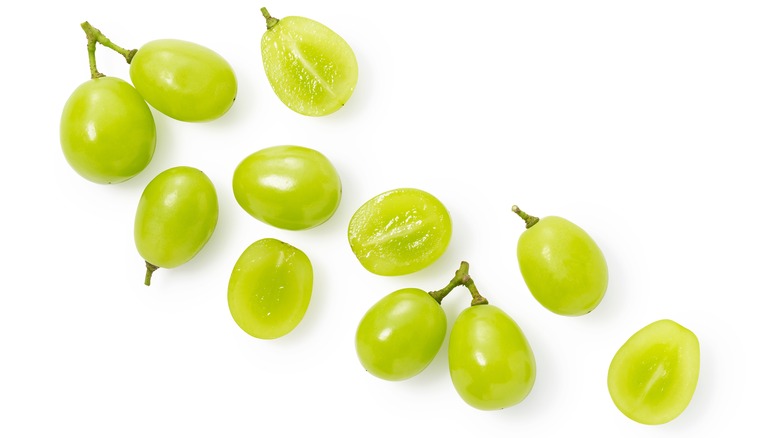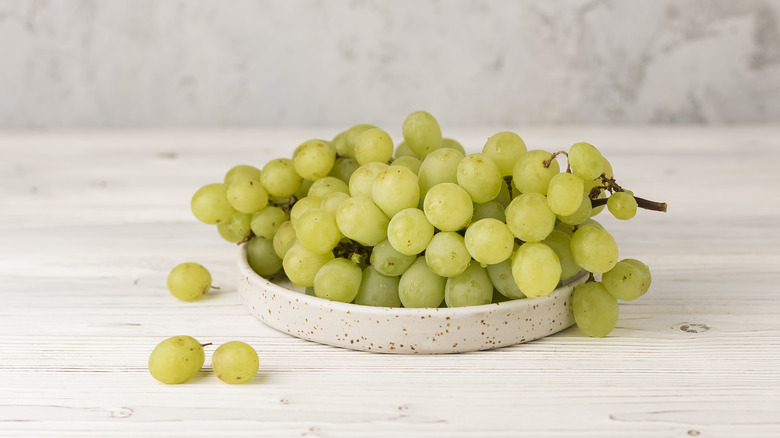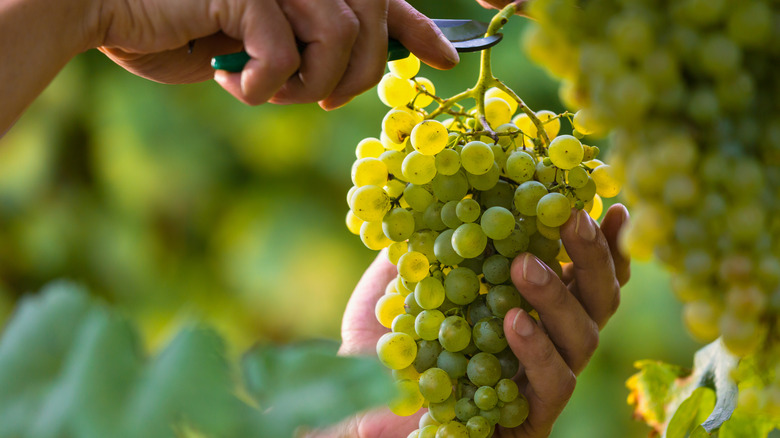What Are Cotton Candy Grapes And What Do They Taste Like?
How do you know you've struck gold in the produce aisle? When you're perusing the grapes and a flash of pink packaging catches your eye. This is none other than the highly sought-after Cotton Candy grapes, an unassuming yellowish-green berry that grips the world's attention every summer and sees repeated surges of popularity, intrigue, and skepticism. We had a hard time being sold on these grapes too, considering that are twice as pricy as the ordinary red table grapes that do the trick just fine. The Cotton Candies are not your ordinary grape, but many rightfully question if even a really really good grape is worth such a premium price. But after trying our first package, consider us converted.
So what's the deal with Cotton Candy grapes? What do they taste like, and are they overpriced? If you've had them before, you probably understand where the hype comes from. Here's everything you need to know about this California creation, including its taste, why it can be so hard to find during the peak grape season, what justifies its cost, and how it's leading the charge for selective species hybridization to create better-testing fruit.
What are Cotton Candy grapes?
Some call Cotton Candy grapes designer fruit. Some call them really expensive produce. Some call them nature's candy. Cotton Candy grapes fetched a lot of attention when they hit store shelves back in 2011. What exactly are these grapes? Where do they come from and why on earth are they so expensive? Before we can answer those questions, let's start at the beginning: Cotton Candy grapes don't actually have anything to do with the airy, spun-sugar circus treat. They are not candied in any way, nor are they junk food.
Cotton Candy grapes are a trademarked product of International Fruit Genetics, or IFG, a California-based producer known for hybrid, specialty fruits. This type of grape is licensed by IFG to certain growers, so the packaging of these grapes should say something along the lines of "IFG licensed." All Cotton Candy grapes are attributed to IFG — if they're not, they're unofficial (not to mention a trademark infringement). Cotton Candy grapes are simply a hybrid form of the fruit — a cross between two different grape species, the horticulturist responsible for this product said in an interview with NPR's The Salt. These grapes are a deciduous fruit, are medium-large in size, and can be round or oval in shape. They are also naturally seedless. There's a lot about the unusual nature of these grapes that leads people to question their composition and nutritional information, sugar content, and GMO and organic status, and we'll get into all of it.
How are Cotton Candy grapes made?
So if they aren't spun out of sugar or genetically modified for deliciousness, how did someone ever pull off growing grapes that taste like cotton candy? In his interview with NPR's The Salt, David Cain — he's the horticulturist responsible for Cotton Candy grapes — explains the process. Per Cain, the naturally-occurring sweetness and flavor of grapes have slowly diminished as grapes were bred to hold up better against commercial transport and storage.
In order to restore some of that candy-like sweetness, Cain brought two species of grape together. This sort of hybridization of fruits isn't entirely new; you may have seen the peacharine, a hybrid of peaches and nectarines, or the limequat, which is a key lime and kumquat mash-up. We'll never know the identity of one of those grape species that creates the Cotton Candies — it's a trade secret held by Cain's company, International Food Genetics, although Cain stated that it's something similar to a Concord — but that mystery grape is cross-bred with the species Vitis vinefera, more commonly called the table grape. Cotton Candy grapes are seedless, so natural reproduction of this hybrid's plants isn't possible. Instead, embryos from the plants are carefully cultivated in lab test tubes. It's a real case of better living (and eating) through science.
Are Cotton Candy grapes genetically modified?
Many consumers want to be conscious of the presence of GMOs, or genetically modified organisms, in the products they're purchasing, especially in fresh produce. The World Health Organization defines a genetically modified food (or ingredient) as one in which the DNA of that product isn't its naturally-occurring DNA. The DNA of that product has been altered through genetic engineering, which is done for a variety of reasons: To boost nutritional value, reinforce durability against herbicides, elements, diseases, and pests, or increase crop yield. In some instances, genetic modification is done to improve or alter taste as well.
Are the wonderful Cotton Candy grapes genetically modified organisms? They are not. Instead, this grape varietal was produced by selective plant breeding, a technique that humans have been using for thousands of years, all the way back to the dawn of agriculture. We should note that there's no evidence that the GMO crops currently on the market have negative health effects, but if you do happen to want to avoid GMOs, Cotton Candy grapes are fine to eat.
Are Cotton Candy grapes organic?
Lots of shoppers seek out organic products at the grocery store if they can afford them. There is a list of specific standards that the USDA uses to certify food as organic, but the simple definition of organic food is food that wasn't treated with chemicals such as pesticides or synthetic pesticides — or, in the case of animal products, it means animals that weren't administered hormones or antibiotics.
Organic products are usually more expensive than their non-organic counterparts, and the higher price tag on Cotton Candy grapes certainly seems at face value like it reflects an organic status. However, whether or not the grapes are organic will depend on the producer. The Grapery is the leading grower of this designer fruit in the United States, and this California-based producer discloses the use of environmentally-friendly pesticides. This means its Cotton Candy grapes are not organic. However, organic cotton candy grapes may be available in your area from other producers. When in doubt, check the label.
Do Cotton Candy grapes really taste like cotton candy?
Cotton Candy grapes definitely aren't as sugary-sweet as the cloudy carnival confection, but after years of buying these grapes ourselves, we can confidently say that they do, in fact, deliver a strong initial taste of cotton candy. These grapes definitely have a more robust and enjoyable flavor than other table grapes that you can get from the supermarket. The flavor is the most distinct when you first bite in to the grape, but even once that actual taste of cotton candy dissipates, the grape is pleasantly sweet with a subtle hint of vanilla.
Regular green grapes are tarter than Cotton Candy grapes, and underripe or otherwise bad berries in the batch can actually be quite sour. Cotton Candy grapes don't share this characteristic; while you're still likely to end up with a funky grape or two in the bag, we've never had a Cotton Candy grape that was overtly sour. These fruits deliver on the sweetness promised by their name.
The difference between Cotton Candy grapes and other grapes
For most of us, the distinction between different grapes available at the grocery store stops at red and green. But did you know that there are a ton of different types of grapes? As a matter of fact, the state of California alone grows 81 varieties of grapes across all of its harvests, according to the California Table Grape Commission. These berries can be categorized into two main types: eating grapes and wine grapes. Others grape varieties are defined based on where they're grown, and some are considered a distinct type because they're the creation of a specific grower. That is the case with IFG's Cotton Candy grapes.
In our experience, Cotton Candy grapes are typically on the firmer side and very juicy, more so than other table grapes. These grapes also tend to have a more yellow hue than other green grapes. Cotton Candy grapes will also likely never be fermented to create wine, as many types of grapes are. Some grapes are versatile enough to be juiced, made into wine, turned into jelly, or plucked right from the vine for snacking — but Cotton Candy grapes will probably always be available mainly as whole fruits because of how intensive their cultivation is and how high the demand for them is. If you want Cotton Candy grape wine, you'll have to make it yourself.
Where can you buy Cotton Candy grapes?
What grocery stores are known to carry these elusive, scrumptious grapes? There are licensed Cotton Candy grape growers in 13 countries, and they collectively produce over 34,000 tons of the delicious fruit every year. When it's in season, you can get the product from these grocers: Sprouts, Costco, Sam's Club, Tesco, Whole Foods, Kroger, Marks and Spencer, Albertsons, and Safeway.
That list is not exhaustive, though, as there are smaller, regional stores where Cotton Candy grapes might be sold. According to The Grapery, their trademarked Cotton Candy grapes are sold in every U.S. state, plus select Canadian provinces. Other chains mentioned on The Grapery's "Find Our Grapes" map include Super Savers, Niemann's, Publix, Ralphs, and Meijer. We've seen cotton candy grapes, whether from The Grapery or a different cotton candy grape grower, on shelves at Trader Joe's, Hy-Vee, and Aldi locations throughout the Midwest.
Why are Cotton Candy grapes so expensive?
Grapes are not usually on the top of the list when we think of expensive fruits, but tossing a couple bags of Cotton Candy grapes in your grocery cart for the family to snack on will certainly lighten your wallet more than plain old red table grapes would. At our local grocery store, Cotton Candy grapes are $5.99 per pound right now — over two dollars per pound more than the red seedless grapes, which retail for $3.49 per pound. According to Statista, the nationwide average price of seedless grapes was $2.24 per pound in 2021. Even regular grapes are hitting our wallets where it hurts in 2023 — but why are Cotton Candy grapes so much more expensive?
The simple answer is that when you buy Cotton Candy grapes, you're paying for the immense amount of labor that goes into their harvest — it's a very short growing season — plus the extensive amount of research and science that went into their development. After all, scientists worked on these grapes for a decade before they were ever put on a grocery store shelf, and dozens of grape varieties were tested to find the perfect hybrid. There's also some classic supply and demand at play; usually, there aren't enough Cotton Candy grapes to go around for all of those who want them.
When are Cotton Candy grapes in season?
You might be lucky enough to find some Cotton Candy grapes on shelves in the off season — in fact, we just purchased a bag ourselves here in the upper Midwest, but early March is generally the very beginning of Cotton Candy grape season. In order to get the juiciest, freshest fruit, keep an eye out during the growing and harvest window, which is unfortunately quite narrow. It varies slightly by the producer. For example, Fresh Farms, which is based in Arizona and Mexico, says its Cotton Candy grapes are available from March through July. On the other hand, the Cotton Candy grapes grown in Southern California by The Grapery are most likely to appear in stores only from mid-August through mid-September.
Between these two major producers, the summer is mostly covered for cotton candy grape availability. And even though there is a slight gap between each grower's season between July and August — this is when The Grapery is hard at work cultivating its grapes, and Fresh Farms' vineyards in Mexico have an earlier growing season due to the warmer climate, with peak grape harvest happening in May — we've seen the grapes crop up at nearby grocery stores all summer long. The supply tends to peter out around October.
Nutritional information for Cotton Candy grapes
No one needs to be told that Cotton Candy grapes are better for you than the circus fare after which the grapes were named. But are Cotton Candy grapes worse for you than regular grapes? Unfortunately, there's some warring information out there, and no Cotton Candy grapes we've purchased have had a handy nutrition label to review. Some sources claim that Cotton Candy grapes are loaded with sugar: nearly double the amount of sugar as regular green table grapes. Others say that there's no more cause for dietary concern with the Cotton Candy grapes than there is with regular ones and that these trademarked grapes contain 50 calories and 14 grams of sugar per serving, very close to the numbers of red and green table grapes.
Perhaps the most reliable source is NPR's interview with Cain on The Salt, in which NPR states that the Cotton Candies do in fact contain about 12% more sugar than normal grapes, a total of roughly 18 grams of sugar per serving. If you can look past the conflicting sugar information, Cotton Candy grapes have a number of other health benefits. They're packed with antioxidants and their skin is loaded with fiber. Speaking generally about grapes, this fruit is a valuable source of copper, vitamin K, vitamin B6, and potassium.
Can you cook with Cotton Candy grapes?
There's no rule preventing you from using Cotton Candy grapes anywhere else you use regular grapes — chicken salad, charcuterie — but if you're looking for unique ways to use up Cotton Candy grapes (assuming they even last that long, since they're never around for more than a day or two for us) there are a couple of ideas out there. You could always bring the designer fruit and its namesake together by making Cotton Candy grape pops, an indulgently sugary treat where grapes are dipped in marshmallow creme and rolled in sugar that's colored the same pastel blues and pinks of classic cotton candy.
Or you can turn these grapes into a delicious late-summer treat. You can blend an entire bag of frozen Cotton Candy grapes in a blender or food processor until they're smooth. Then, add some sugar, water, and lime juice, then bam — you've got Cotton Candy grape sorbet. Lastly, if you're looking to entertain an adult crowd, try soaking a bag of Cotton Candy grapes in sugar plus your choice of booze for a sweet treat with a kick.
Why are Cotton Candy grapes so hard to find?
So why are Cotton Candy grapes so hard to find? These are the perfect fruit for the summer — they're a sneaky way to get kids to hydrate, an easy snack to pack for camping and trips to the beach, and little sponges for all your favorite spirits — so why isn't there enough supply to go around by now, considering the fact that Cotton Candy grapes have been on the market for overa decade?
Let's look at the California market for grapes alone — the state produces roughly 97 million boxes of the crop every year, across 81 different varieties. California's grape industry was worth $2.14 billion in 2021. The state produces nearly a million tons every year. The global supply of Cotton Candy grapes — 34,000 tons per year from the combined crop of every grower in the world — is minuscule compared to California's total grape production. That's because Cotton Candy grapes, unlike all of the regular table grapes out there, are grown for the taste of the product rather than size and speed of yield. This, combined with Cotton Candy grapes being a trademarked product that only licensed growers can produce, means that production of the grapes is not likely to ever meet the level of demand. And since the grapes are only getting more popular from here, having been talked about in major media sources for years, this tasty summertime fruit's celebrity status will probably persist.
